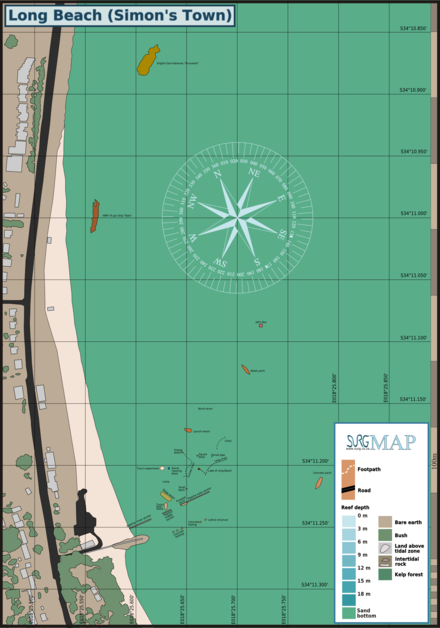The dive site HNMS Bato is an inshore historical wreck in the Simon's Town area on the False Bay coast of the Cape Peninsula, near Cape Town in the Western Cape province of South Africa.
Understand[edit]


Position[edit]
- 1 HNMS Bato wreck: S34°10.998’ E018°25.560’ — About 50 m offshore off the north end of Long Beach, Simon’s Town.
This site is in the Table Mountain National Park Marine Protected Area since 2004. A permit is required.
Name[edit]
"His Netherlands Majesty's Ship Bato" was a Dutch warship of 800 tons and 74 guns. The ship had been used as a floating battery in Simon’s Bay for several years. Set on fire and sunk off Long Beach, Simon's Town, on 8 January 1806, the same day that the Battle of Blaauwberg began. The Batavian Republic forces at the Cape capitulated to the British forces two days later. The wreck has been worked on and cannon from the site stood outside the Simon's Town Post Office.
Depth[edit]
Maximum depth is about 4 m. Average depth is likely to be about 3 m.
Topography[edit]
The wreck lies in shallow water (about 3.5 m) The area is fine sand with some low sandstone reef to the South. The wood structure of the wreck has become very overgrown over the years and is not easily recognisable over large areas The wreck lies approximately parallel to the shoreline. The centreline of the debris field is nearly North/South True, from S34°11.012’ E018°25.558’ to S34°10.985’ E018°25.561’, It is about 50 m long, 8 m wide and it extends over an area of about 400 m2. There is a large mass of corroded iron at S34°11.008’ E018°25.552’, and some copper sheathing at the north end of the wreckage
Conditions[edit]
Protected area, but shallow. Can be dived if the swell is low. Generally best in winter.
Facilities[edit]
The parking lot is tarred and in good condition. There is a fresh water shower, but on occasion the taps have been sawn off. The public toilets are shabby and may not be open.
Get in[edit]
Parking at the tarred parking lot at Long Beach behind the railway station. There is a walk of about 450 m along the beach from the slipway gap to a small brick building. The wreckage of the Bato is visible from the shore on a calm day as a dark patch of weed about 50 m offshore.
See[edit]
Marine life[edit]
The wreckage is largely overgrown with kelp and seaweeds, and has shallow water invertebrates, and often a few fish
Features[edit]
Historical wooden shipwreck. The wreckage is low and heavily overgrown with seaweed and invertebrates. The wreck is protected by legislation and may not be disturbed.
Photography[edit]
The water is very shallow, and natural light should allow almost any equipment to be used, but the subject matter is rather limited.
Routes[edit]
Swim straight out to the wreck on the surface, Dive and explore the wreck, then swim back to shore on compass bearing 330° magnetic.
Stay safe[edit]
Hazards[edit]
No known site specific hazards.
Skills[edit]
No special skills required. Suitable site for novice snorkellers
Equipment[edit]
A light is useful for looking into dark crevices. An extra weight might be useful to keep you under water if your buoyancy is normally neutral at the surface.
Nearby[edit]
- 1 P87
- 2 SS Clan Stuart
- 3 Brunswick
- 4 Long Beach
- 5 Simon's Town Jetty
- 6 False Bay Yacht Club moorings
- 7 Target Reef
- 8 Spider Crab Reef
- 9 Ammunition Barges
- 10 Phoenix shoal
- 11 Noah’s Ark Rock
Back to the Alphabetical list of sites, or list of dive sites in the Simon's Town area
Other regional dive sites:

